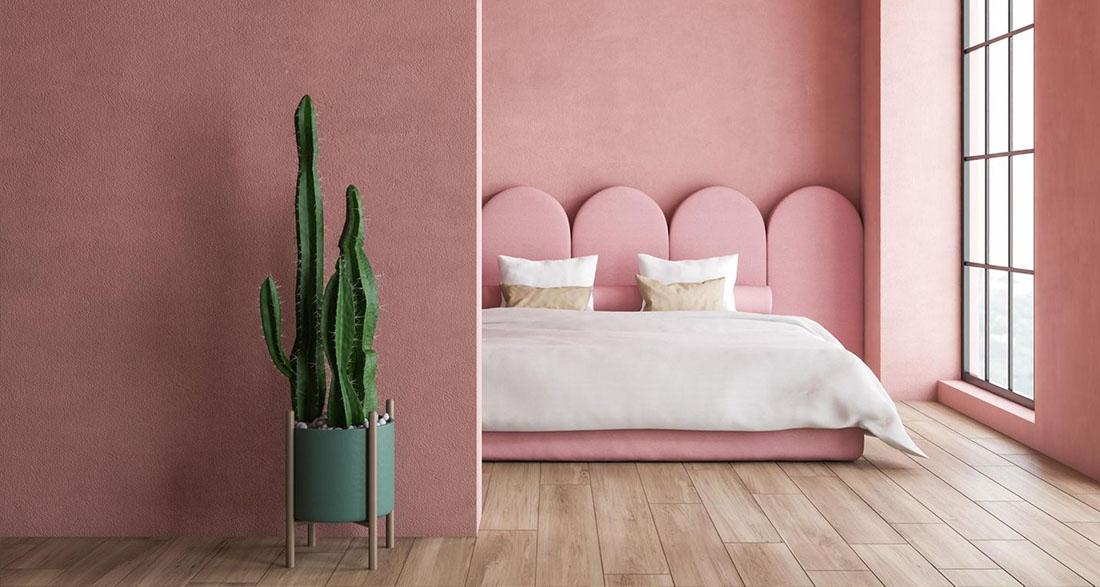The quality of our sleep depends on many factors—one of them being the colors in our bedroom. We reveal which shades contribute to restful sleep and a positive mood.
We constantly experience how strongly colors influence our mood in everyday life. The bright yellow glow of the sun lifts our spirits, while the dull gray of the dark season tends to feel depressing. Some restaurants even choose specific colors for their interiors to stimulate appetite or encourage guests to leave quickly after eating.
And in perhaps the most important room of our lives, colors also play a significant role: The way we design our bedroom not only affects the quality of our sleep but also how we feel the next day. Our brain processes 99% of color information unconsciously—this is why the colors in the room where we sleep are especially important.
Color Psychology: These Shades Improve Sleep and Mood
1. Pink for Calmness & Relaxation
Soft pink tones are among the best colors for the bedroom because they have a calming effect and promote sleep. In a pink-colored environment, we can immediately unwind.
2. Blue for More Peace & Security
According to color experts, blue is also a top choice for our sleeping spaces. Studies have shown that blue tones have a relaxing and soothing effect on the brain. This means that in a blue bedroom, we can not only unwind and fall asleep more easily but ideally wake up feeling refreshed and happy.
3. Green Helps Reduce Stress
Green is associated with nature—that’s how our brain perceives it. This signal helps us slow down and leave the worries of the day behind. Additionally, green shades symbolize balance, making them the perfect anti-stress colors. However, the chosen hues should not be too dark, as this could counteract relaxation.
4. Beige & Brown for Coziness
Brown and beige are also natural tones that our brain finds very pleasant. They create an inviting and cozy atmosphere, making them ideal for the bedroom. However, it’s important to ensure that the shades are not too dark, as this could disturb restful sleep.
5. Yellow for a Good Mood
First things first: If you’re trying to calm an overactive mind, yellow may not be the right color. However, it does wonders for boosting mood! So, if you struggle with sleep issues, you should—if at all—opt for a very soft vanilla-like shade. But if you have trouble getting out of bed in the morning and tend to be a grumpy riser, yellow can be the perfect mood booster for you!
Avoid These Colors in the Bedroom
You should avoid painting your bedroom walls in very dark and intense shades like purple or even black. These colors tend to be stimulating and can negatively impact sleep quality. Very bright colors, such as neon pink or orange, are also not a good idea, as they make it difficult for us to relax.
Better Sleep: Other Important Bedroom Considerations
Besides choosing the right wall and decor colors, there are other factors that contribute to good sleep and a relaxed atmosphere in the bedroom.
- Keep your bedroom as tidy as possible. A structured and clutter-free space helps our minds find peace and clarity. Making your bed daily and keeping clothes off the floor can make a big difference.
- Ensure the room isn’t too bright. Blackout curtains or blinds can help improve sleep quality.
- Maintain a cool temperature. Experts recommend a maximum of 18°C (64°F) for optimal sleep.
- Keep electronics out of the bedroom. Sleep is calmer and healthier when electronic devices are minimized. If you can’t part with your phone or tablet, use it in airplane mode to reduce exposure to radiation.






